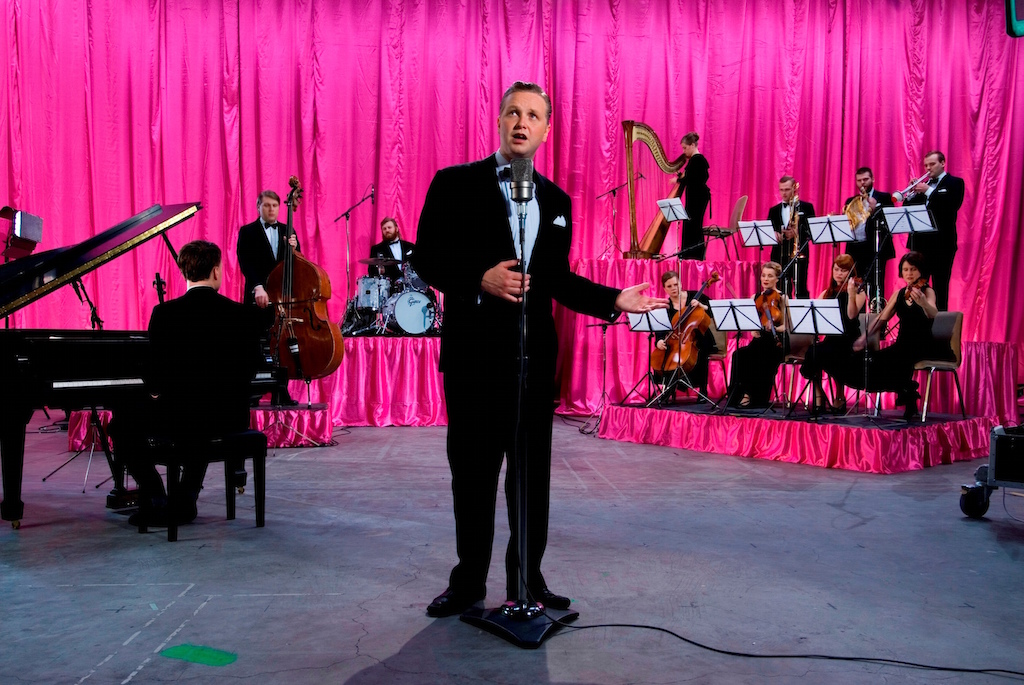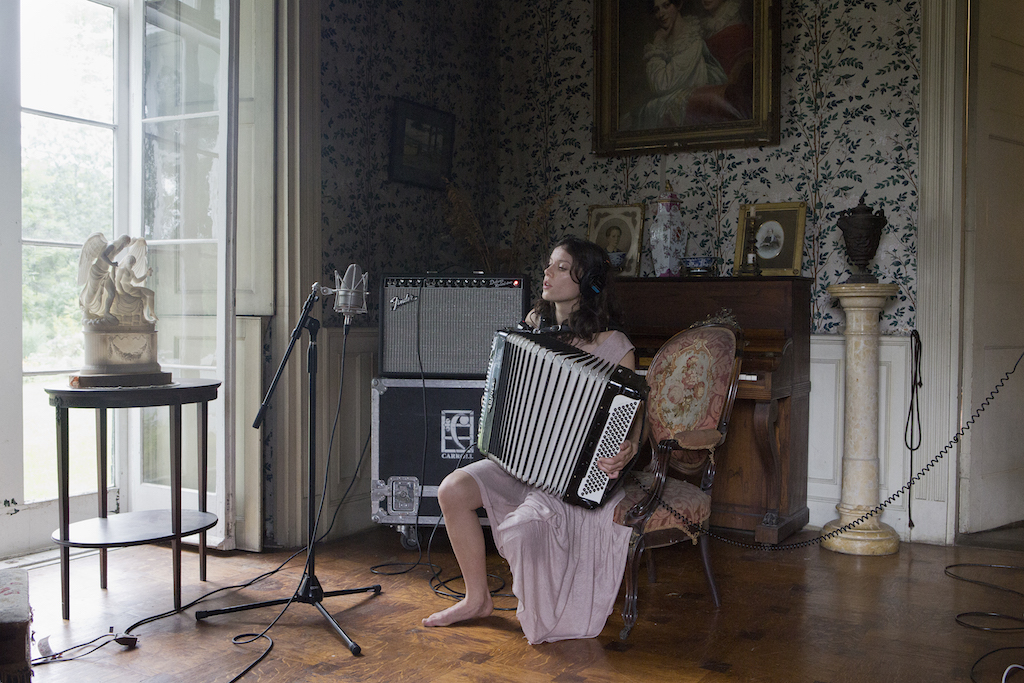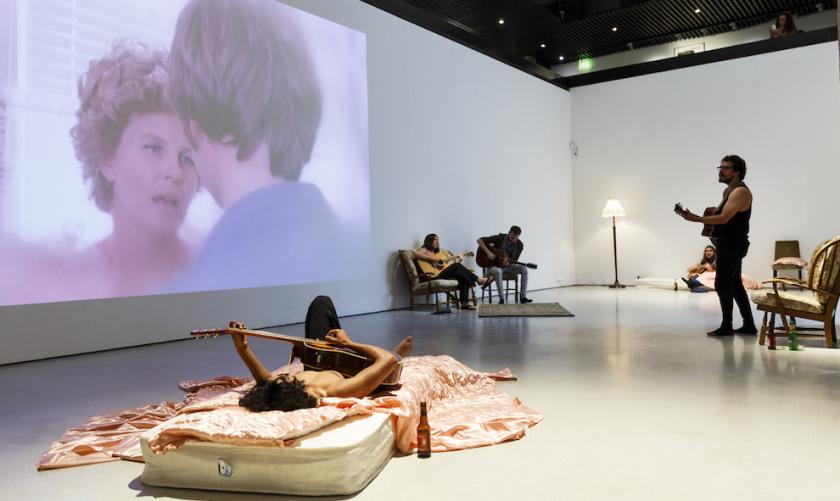A neon sign over the Barbican’s Silk Street entrance reads Scandinavian Pain. Following its victory over us in Euro 16, it seems that Iceland is now drenching us with its special brand of melancholy. Things are not that simple, of course. In his work, Icelandic artist Ragnar Kjartansson indulges his penchant for sorrow with such bitter sweetness that, with many a gentle sigh, emotional pain morphs into something more akin to pleasure.
In any case, he is hard pressed to distinguish real emotion from its ersatz other, since he was born into an acting dynasty and, as a child, spent many hours watching from the wings as his mother and father portrayed the imagined feelings of numerous fictional characters. His parents met on the set of Murder Story, a film shot in 1975. Projected large onto the wall of the gallery is a clip showing Kjartansson’s mother, Guôrún Ásmundsdóttir (Iceland’s equivalent of Judy Dench), dreaming of an erotic encounter with the plumber, played by her future husband (main picture). Vaseline smeared onto the lens gives the sordid little scene a glimmer of fake romance, as the bored housewife rips off the tradesman’s shirt while urgently whispering, “Take me here by the dishwasher.” Since family mythology has it that the artist was conceived mid-production, the sex scene that follows could well be a precursor to his actual conception. Fact and tawdry fiction intertwine to a fascinating degree.
Ten guitarists lounge around the gallery on the kind of furniture seen in the film. For eight hours at a stretch, they sing snippets of the dialogue that intertwine to produce a melancholy ditty about loneliness, lust and longing and the romantic clichés that nurture them. While many of us have a soft spot for silver screen soppiness, few can claim direct descent from a celluloid romance that continued between the sheets in real life. Take me here...is, then, a meditation on the way popular culture and celebrity romances influence our ideas about love, while also being a celebration of the artist’s own origins. Permeating the entire exhibition space, the maudlin harmonies create a mood of languid eroticism that is unlikely ever to find satisfaction.
 Given his background, its scarcely surprising that Kjartansson seems to inhabit a twilight zone in which the real and the fictional intertwine. Across the pages of a notebook, he has written “Is this real life”; and no matter what medium he adopts, his work explores the relationship between drama and genuine feeling.
Given his background, its scarcely surprising that Kjartansson seems to inhabit a twilight zone in which the real and the fictional intertwine. Across the pages of a notebook, he has written “Is this real life”; and no matter what medium he adopts, his work explores the relationship between drama and genuine feeling.
In the video God, 2007 (pictured above) he assumes the persona of a tuxedo-wearing crooner with slicked-back hair and a cheesy grin. Red satin curtains line the room; they match the copious drapes framing the set on which an orchestra strikes up a schmaltzy ballad and Kjartansson sings Sorrow conquers happiness. He repeats this solemn mantra over and over for half an hour until, eventually, embracing sorrow begins to feel like a welcome relief from the false cheeriness that travels across the Atlantic with other American imports.
A Lot of Sorrow, 2014 is a beautifully atmospheric video of the American indie band, The National, repeatedly performing Sorrow from their album High Violet during a six-hour stint for a live audience at MoMa PS1 in New York. As lead singer Matt Berninger intones for the umpteenth time “Sorrow found me when I was young/ Sorrow waited, sorrow won”, painful memories seem to accrue and assume an almost ecstatic intensity.
The Visitors, 2012 (pictured below) was shot in Rokeby Farm, a crumbling mansion in upstate New York crammed with antiques and fine furniture. A group of musician friends from Reykjavik took up residence, one to a room, and in a nine-screen installation we see them simultaneously playing their instruments and singing the refrain “Once again I fall into my feminine ways”. The title of the piece comes from the last album made by ABBA before their split, and the hour-long performance of this melancholy chorus seems to reprise the gradual breakdown of a relationship.
Ultimately, though, the mood is upbeat. After their solitary explorations of failure, the musicians gather on the lawn and wander off together into the landscape. Watching them disappear across the fields, I was reminded of Antoine Watteau’s painting Embarkation for Cythera, 1719, showing a group of young people setting off to party on the mythic Greek island of love.
During his stay at Rokeby, Kjartansson also explored the mythic image of the plein-air painter in a performance that was recorded in black and white photographs and as a clutch of feeble landscape paintings. He undertook a similar project for the Venice Biennale of 2009. Day after day for six months, the artist made paintings of his friend Páll Haukur Björnsson smoking, drinking beer, strumming a guitar or gazing at the Grand Canal through the windows of a 14th century palazzo.
The notion of picture making as a performance is not new, of course (think of Jackson Pollock), but the product has usually been as important as the process. Acting as a painter is one thing, producing the goods is quite another and, unfortunately, Kjartansson has no skills as a draughtsman. Whereas every detail of his videos is carefully considered and beautifully executed so the misery they purvey is transformed into sheer delight, his paintings are poor enough to undermine the cleverest concept. This is one instance in which the merging of fact and fiction is not amenable to fudge. You could say it is Ragnar Kjartansson’s Nemesis, the moment in which reality strikes back.










![SEX MONEY RACE RELIGION [2016] by Gilbert and George. Installation shot of Gilbert & George 21ST CENTURY PICTURES Hayward Gallery](/sites/default/files/styles/thumbnail_125_x_125_/public/mastimages/Gilbert%20%26%20George_%2021ST%20CENTURY%20PICTURES.%20SEX%20MONEY%20RACE%20RELIGION%20%5B2016%5D.%20Photo_%20Mark%20Blower.%20Courtesy%20of%20the%20Gilbert%20%26%20George%20and%20the%20Hayward%20Gallery._0.jpg?itok=3oW-Y84i)




Add comment